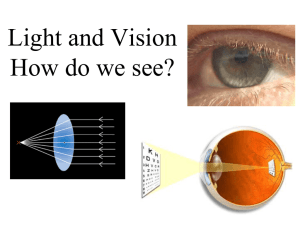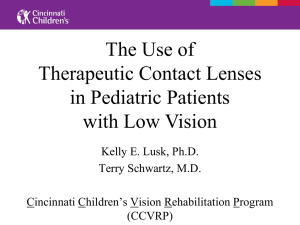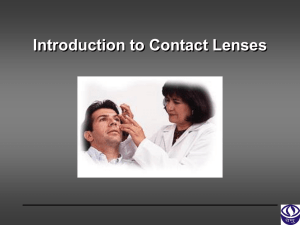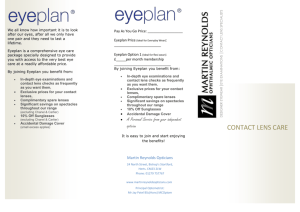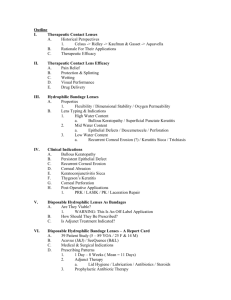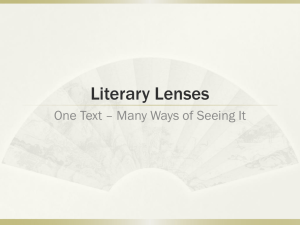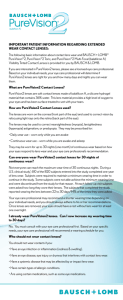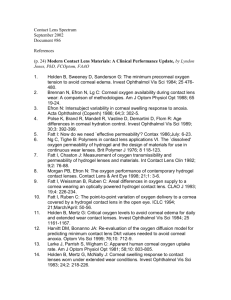Study on the efficacy and tolerability of a new ophthalmic solution
advertisement
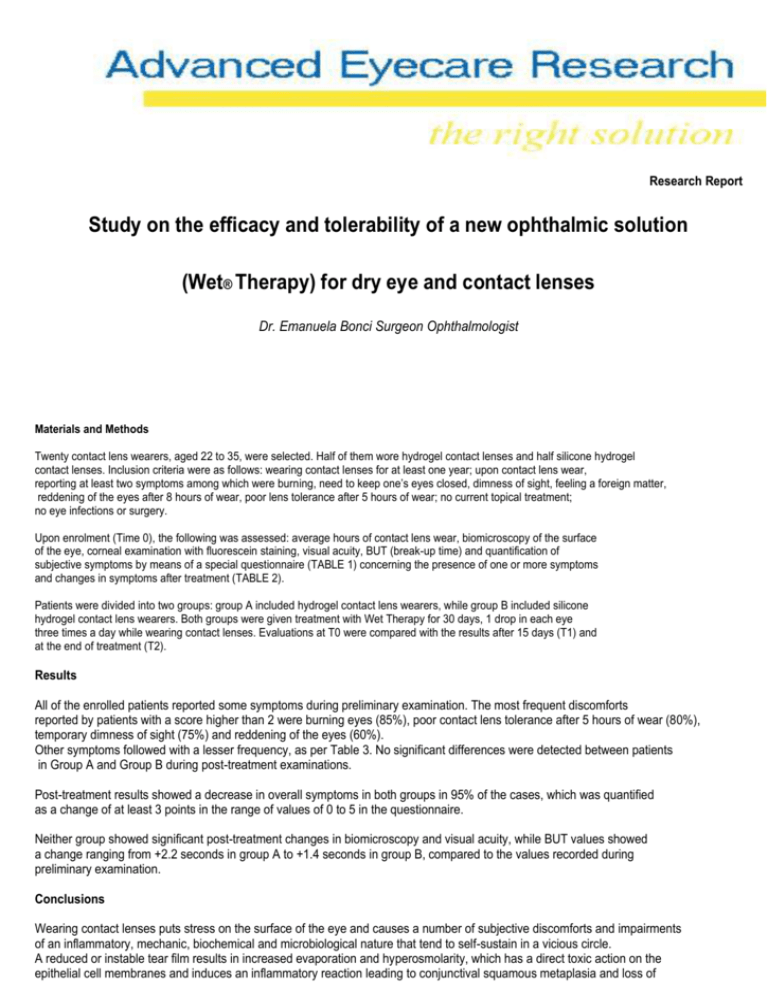
Research Report Study on the efficacy and tolerability of a new ophthalmic solution (Wet® Therapy) for dry eye and contact lenses Dr. Emanuela Bonci Surgeon Ophthalmologist Materials and Methods Twenty contact lens wearers, aged 22 to 35, were selected. Half of them wore hydrogel contact lenses and half silicone hydrogel contact lenses. Inclusion criteria were as follows: wearing contact lenses for at least one year; upon contact lens wear, reporting at least two symptoms among which were burning, need to keep one’s eyes closed, dimness of sight, feeling a foreign matter, reddening of the eyes after 8 hours of wear, poor lens tolerance after 5 hours of wear; no current topical treatment; no eye infections or surgery. Upon enrolment (Time 0), the following was assessed: average hours of contact lens wear, biomicroscopy of the surface of the eye, corneal examination with fluorescein staining, visual acuity, BUT (break-up time) and quantification of subjective symptoms by means of a special questionnaire (TABLE 1) concerning the presence of one or more symptoms and changes in symptoms after treatment (TABLE 2). Patients were divided into two groups: group A included hydrogel contact lens wearers, while group B included silicone hydrogel contact lens wearers. Both groups were given treatment with Wet Therapy for 30 days, 1 drop in each eye three times a day while wearing contact lenses. Evaluations at T0 were compared with the results after 15 days (T1) and at the end of treatment (T2). Results All of the enrolled patients reported some symptoms during preliminary examination. The most frequent discomforts reported by patients with a score higher than 2 were burning eyes (85%), poor contact lens tolerance after 5 hours of wear (80%), temporary dimness of sight (75%) and reddening of the eyes (60%). Other symptoms followed with a lesser frequency, as per Table 3. No significant differences were detected between patients in Group A and Group B during post-treatment examinations. Post-treatment results showed a decrease in overall symptoms in both groups in 95% of the cases, which was quantified as a change of at least 3 points in the range of values of 0 to 5 in the questionnaire. Neither group showed significant post-treatment changes in biomicroscopy and visual acuity, while BUT values showed a change ranging from +2.2 seconds in group A to +1.4 seconds in group B, compared to the values recorded during preliminary examination. Conclusions Wearing contact lenses puts stress on the surface of the eye and causes a number of subjective discomforts and impairments of an inflammatory, mechanic, biochemical and microbiological nature that tend to self-sustain in a vicious circle. A reduced or instable tear film results in increased evaporation and hyperosmolarity, which has a direct toxic action on the epithelial cell membranes and induces an inflammatory reaction leading to conjunctival squamous metaplasia and loss of conjunctival secreting capacity. International literature suggests how treatment, simultaneously, if possible, should affect all of the components in the vicious circle that contribute to causing and retaining dry eye due to contact lenses. The application of artificial tears is particularly recommended in this case. The results of treatment with Wet® Therapy fully tally with data in the literature. Pre-clinical and clinical studies show that hyaluronic acid is a well-tolerated tear substitute with a very low rate of side-effects that reduces symptoms and impairment of the surface of the eye in dry eye patients and facilitates contact lens application and tolerability. Wet® Therapy, E. Bonci 2 Research Report Table 1 Questionnaire on subjective symptoms reported during preliminary examination (T0) Symptoms felt after treatment: please, give a score between 0 (no symptoms) and 5 (most severe and/or frequent symptoms) Burning Lacrimation Temporary dimness of sight Feeling a foreign matter Reddening of the eyes Poor tolerance of contact lenses after 5 hours of wear Need to keep one’s eyes closed ------------------------------------------------------------------------------------------------------------------------------------------------------------------------------------------------------------------------------------------------------------------------------------------------ These symptoms increase with: Cigarette smoking Air conditioning Wind Table 2 Questionnaire on subjective symptoms reported after treatment (T1 T2) After treatment with artificial tears I noticed: •that symptoms decreased • that symptoms increased •no difference Symptoms felt after treatment: please, give a score between 0 (no symptoms) and 5 (most severe and/or frequent symptoms) Burning Lacrimation Temporary dimness of sight Feeling a foreign matter Reddening of the eyes Poor tolerance of contact lenses after 5 hours of wear Need to keep one’s eyes closed After applying artificial tears, I noticed: ----------------------------------------------------------------------------------------------------------------------------------------------------------------------------------------------------------------------------------------------------------------------------------------------- that symptoms decreased generally that my tolerance of contact lenses increased Yes Yes No No Wet® Therapy, E. Bonci 3 Research Report Table 3 Overall results from the questionnaires on subjective symptoms reported during preliminary examination and after treatment (T2) Symptoms % of patients who reported the symptom (>2) before treatment Patients with a decrease in symptoms =/> 3 points after treatment Group A Burning 85% (17 patients) 6 patients 6 patients 70% (12 patients) Temporary dimness of sight 75% (15 patients) 8 patients 5 patients 80% (13 patients) Feeling a foreign matter 55% (11 patients) 4 patients 4 patients 73% ( 8 patients) Reddening of the eyes 60% (12 patients) 2 patients 3 patients 43% ( 5 patients) Poor tolerance of contact lenses after 5 hours of wear 80% (16 patients) 8 patients 7 patients 94% (15 patients) Need to keep one’s eyes closed 30% (6 patients) 4 patients Overall symptoms 100% (20 patients) 11 patients Patients with a decrease in symptoms =/> 3 points after treatment Group B Total % of patients with decreased symptoms in Groups A and B 65% (4 patients) 8 patients (1) Green K, MacKeen DL, Slagle T, Cheeks L. Tear potassium contributes to maintenance of corneal thickness. Ophthalmic Res. 1992;24(2):99-102. (2) Gilbard JP, Rossi SR. An electrolyte-based solution that increases corneal glycogen and conjunctival goblet-cell density in a rabbit model for keratoconjunctivitis sicca. Ophthalmology. 1992 Apr;99(4):600-4. (3) Bachman WG, Wilson G. Essential ions for maintenance of the corneal epithelial surface. Invest Ophthalmol Vis Sci. 1985 Nov;26(11):1484-8. 95% (19 patients) Wet® Therapy, E. Bonci 4


